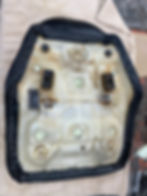New Seat Foam for 1984 Honda Big Red 200ES ATC
- justbigreds
- Dec 7, 2022
- 3 min read

New seat foam is one of the best upgrades you can do for BIG RED. Unfortunately I cannot find someone who sells replacement seat foam for the 200ES currently. This means I will have to do some upholstery work which I have very little experience doing. It can be done but if new seat foam is offered at a reasonable price in the future I will most likely purchase it.
My plan from the beginning of the project was to make a larger "overstuffed" seat for more comfort. Even though I was making a larger I had to make sure a replacement cover would still fit. I also had to make sure it fit on the ATC between the rear rack and the gas tank. I did an "overstuffed" seat on a 250ES and it worked out great so I wanted to do it for the 200ES which doesn't have rear suspension.
I bought the replacement seat foam on the interwebs from the foam factory. I used the 3" and 1" thick Supermax foam and put them together with 3M Super 77 spray adhesive. 4" Supermax foam was not available at the time of this project. I also bought some Fiberfill from the foam factory. This is used on top of the foam to help with imperfections. The adhesive I used is 3M Super 77. You should be able to get this from hardware stores.
Here's the list of some tools I used for this project:
Electric carving knife - Used to cut the foam. A serrated knife could be used too.
Air die grinder with abrasive disc - used to shape foam. A tool made from a jar lid can be used too.
Air stapler with staples - used to attach the seat cover. An electric stapler can be used too.


I got this seat cover from a swap meet. It was in pretty rough shape but the seat pan was good.

After removing the seat cover and foam I placed the seat pan on some paper and using a pencil traced the shape of the seat pan.


I used two dial calipers to transfer the impressions and depressions of the original seat foam onto the paper template.

Cut out the template.

Place paper template on original seat foam to make sure it is correct.

Before proceeding I will use a thread restorer to make sure the threads for the seat latch and toolbox are good.



Stacked the new seat foam to rough in the shape. I used the 3M Super 77 adhesive to stick the foam layers together.


Used template to mark up seat foam for cutting

Colored in the section that will remain.

Used razor blade to cut out the foam for the seat pan.

Used a dial caliper to measure the depths of the original foam and then used the same measurement for the new seat foam.

Bottom of new seat foam cut out for the seat pan

Seat pan glued to new foam using the 3M spray adhesive


I used cardboard to create templates of the profile of the original seat foam. These templates will be used to mark up the new foam and guide during shaping of the new foam.

An electric carving knife was used to cut the foam

Shaping the foam using a grinder. This is messy so I did it outside.

Shaping the foam.


This foam shaping tool was made using a jar lid. The holes were put in using a hammer and punch. It's like a cheese grader that helps shape the foam after it is roughed in.

I also used an air angle die grinder with a 36 grit disc to help shape the foam.

Shaping the foam.

Test it the cover to make sure it will fit with the oversized foam.

Put a layer of fiberfill over the new foam. This will help hide imperfections in the foam and provide a little extra cushion.


New seat cover installed

Original seat foam

New overstuffed seat foam


More pics of the new seat. It fits well and it feels great.
This project took some time but it was well worth it in my opinion as you feel the difference every time you sit down on it. I took the time to make the templates just in case I want to take this on again. I really hope that someone will start producing seat foam for these machines that are close to 40 years old.
